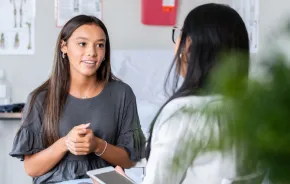Not long after Mary Margaret Callahan took a physics exam at Whitman College in the late ‘90s, her professor said this to the class: “Gentlemen, I am so embarrassed. Every girl scored higher than every boy in this class. But don’t worry, men, trend is not destiny.”
A few short years after that, Lawrence Summers, then president of Harvard University, told an academic conference that innate differences between men and women could be one reason fewer women succeed in math and science careers.
Ultimately, Summers resigned from his position, Callahan became a science and math specialist at the Seattle Girls School, and the rest of us were left to wonder once again just how far females really have come on the educational playing field.
Apparently, not far enough. “In certain science careers, such as computer engineering, women are sorely underrepresented,” says Stacey Roberts-Ohr, executive director of Expanding Your Horizons Network, a California-based organization that encourages young women to pursue careers in science, math and engineering fields. “We are trying to fix that."
An advocacy group called the Math/Science Network says female membership in the National Academy of Sciences is just 10 percent — and that the number of women earning Ph.D.’s in mathematics is declining. And the National Center for Women and Information Technology found that while girls took 56 percent of all advanced placement (AP) tests in 2006, they made up just 15 percent of students taking the AP computer science test.
The math/science world hasn’t looked this dismal for girls since the first talking Barbie doll exclaimed, “Math class is tough!”
It’s not that young girls shun math and science. They do just fine — in fact, they often excel — until they hit middle school, says Rafael del Castillo, a former science and math teacher who’s now assistant head of the Seattle Girls School. “They lose confidence before they lose competence,” he says.
The reason? Girls tend to gather information collaboratively, he says. “They want to explore the process more and go a little deeper — to know the why and the how. Boys are more focused on the answer. They want to do it quickly and get it right.”
Teachers respond with enthusiasm to the male find-the-answer-fast learning model in math and science classes, del Castillo says. That turns the boys into the “good” students — the ones the teacher rewards — while the girls learn to see themselves as minor players. And that’s how self-confidence begins to ebb.
Without constructive experiences, girls won’t stay in science, says Nancy Ruzycki, a former University of Washington research scientist who teaches math and physics at Seattle’s Chief Sealth High School. Not that all Ruzycki’s own experiences have been constructive. Back in high school chemistry, she remembers, the teacher would shout, “Beauty school!” if a female student spoke out of turn.
Finding role models
It doesn’t escape these educators and scientists that strong role models — women who have blazed trails in the math, science and tech world — have never achieved the visibility of, say, a Hannah Montana. “There must be good images out there of creative, successful women,” says Callahan. “But what do girls see on TV? America’s top model? They need mentors.”
Chances are they won’t find them in elementary school. Grade-school teachers, usually generalists, are not highly trained in science, Ruzycki says. And most high school math and science departments are overwhelmingly male.
That leaves middle school, when the social scene claims center stage. “Girls think, do I want boys to like me — or do I want to be the smart girl? Can I be a good student and be pretty and popular?” says Callahan. “At that age, it’s hard for them to see themselves as a little of everything.”
They’re clearly not seeing themselves as computer scientists.
“The perception is that computer science is either a male field or a field for geeks,” says Mylene Padolina, senior diversity consultant for DigiGirlz High Technology Camps. Since 2000, Microsoft has sponsored DigiGirlz Camps, a summer camp for girls that introduces them to careers in the technology industry. The free camps are held throughout the country.
Technology, as Padolina points out, is not just a guy thing. “We want girls to understand there are lots of kinds of jobs in tech fields,” she says. “At Microsoft, there are programmers, developers and testers — but also psychologists, graphic artists and people in other disciplines.”
It’s a curious paradox that young women — more of them than ever — are training to become physicians. According to the Association of American Medical Colleges, the number of women applicants to medical schools in the United States increases yearly, now making up about 50 percent of all applicants.
Why do females give bio class a free pass, but not engineering or physics? Less than 20 percent of Ph.D.’s go to women in physics, notes Ruzycki, who has one.
Everyone has a theory. Ruzycki feels it’s because medicine’s generating a plethora of female role models. “Young women run into other women in biological and medical fields, and that makes a big difference,” she says. “Women in medicine can mentor other women and develop a work/life balance.”
Stacy Roberts-Ohr says women gravitate toward careers that help others. “In medicine, they feel they’re making a contribution,” she says. “They don’t see how computer science relates to the greater good. They think they’d be stuck behind a desk, programming all day.”
Encouraging your scientist
But before — way before — your daughter decides on a career in medicine or engineering or a stint at Microsoft, she needs to stay engaged in the math and science world. How can you help that happen?
Del Castillo’s a big proponent of all-girls schools. “Parents need to look at their child and decide which kind of environment works best,” he says. “A single-sex option should be considered. If girls lose confidence or interest early, they will start down a different path.”
Linda Morgan, ParentMap’s associate editor, writes frequently on education issues.
Resources
Association for Women in Science
GEMS - A science enrichment program for seventh- and eighth-grade girls attending Seattle public schools.
Expanding Your Horizons in Science and Mathematics: Offers conferences to nurture girls’ interest in science and math courses.
DigiGirlz programs at Microsoft: Provide high school girls with opportunities to learn about careers in technology, talk with Microsoft employees about their life experiences, and experience hands-on computer and technology workshops.
Cybercamps Academy : A summer technology program for ages 10-17. To register, include the promo code “suprscigrl.”









